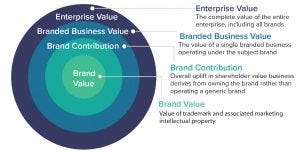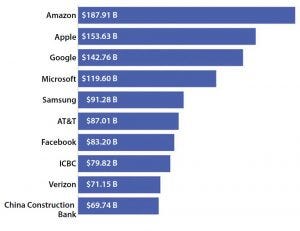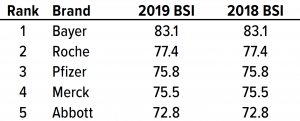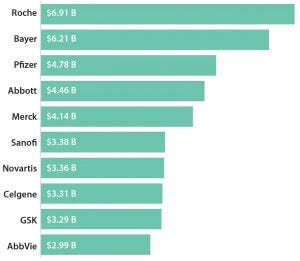Breaking Through the Noise: An Approach to Differentiating Your BusinessBreaking Through the Noise: An Approach to Differentiating Your Business
May 17, 2019
When multiple businesses sell the same type of item, why do customers buy from one supplier rather than another? How are vendors able to break through the “white noise” of an industry to stand apart and get noticed? The current bioprocessing and cell therapy vendor markets, about 50,000 vendors are selling to biomanufacturers, universities, and research institutions (www.bioz.com). How do those suppliers get noticed?
Market-leading suppliers have established brands that allow them to cross-sell, up-sell, and engage in deep selling. For everyone else, differentiating through brand strategies is a vastly underused business strategy that, simply put, more companies should engage in — but are not.
In a world filled with increasing digital noise, new vendors and new business ideas fall flat unless they are accompanied by something more than the basic offering. A new market entrant needs something other than an outperforming product or technology to get noticed. Similarly, bioprocessing and cell therapy supply sectors are filled with businesses that have been in business for decades but have failed to grow.
In today’s mergers and acquisitions (M&A) world, growth typically comes from aggressive acquisition strategies. But success of those deals relies squarely on an acquiring company’s ability to grow the target company by leveraging resources, scale, and brand equity to drive increased pull-through and deliver accretive value.
Breaking through the noise, generating brand awareness, helping to drive pull-through, and delivering accretive value all rely on differentiated brand strategies. To understand better how to establish differentiated brand strategies, you must first understand the economic and competitive landscapes for your business, what defines your brand, and the best way to leverage it to execute against different business objectives.
ECONOMIC AND COMPETITIVE LANDSCAPE
To understand how to differentiate a brand, it is first important to understand the type of market structure that brand is operating within. Market structures can be monopolistic competition, oligopoly, oligopsony, monopoly, or monopsony.
A monopolistic competitive market contains multiple sellers, all offering similar products with slight variations. Those variations allow sellers to create differentiated products and set their own prices.
Oligopolies occur when a few businesses dominate industry through collusion. Often, this is a result of sole access to raw materials, technology, or resources. Those few companies set market prices.
An oligopsony exists when the market has multiple buyers but only a few sellers. One example is the tobacco industry. The buyers (not sellers) set market prices.
A monopoly exists when one business owns the entire market place. This allows a single seller to set the terms, pricing, and regulations for all customers.
A monopsony occurs when a market has several sellers but only one buyer. One example is the military: a single buyer that sets the prices.
Many companies in the world exist within a monopolistic competitive market structure. Buyers of goods and services can set prices, but sellers distinguish themselves by differentiating on quality, service, and brand. That means that although a low-price strategy provides short-term wins for vendors that are first to offer reduced pricing, the long-term industry economics are negative, placing downward pricing pressure across the sector. Economics tells us that the reduced “rents” collected for a product or service provides less working capital for reinvestment into facilities, innovation, personnel, and more over the long term. That is why a brand is so important: It’s an asset for each company, but it also is a tool that many suppliers struggle to use appropriately.
WHAT IS A BRAND?
To understand how to leverage brand strategies, you must first understand what a brand is. But defining a brand and defining a brand strategy are two of the toughest questions that I’ve ever been asked to answer. Given their subjective nature, brands are described best in relation to customers’ emotional or psychological responses to them. That is why many people refer to brands as being “experiential.” In addition to such ethereal qualities, some grounded terms used to describe brands include trusted, familiar, culturally identifiable, and valuable.
BRANDS ARE TRUSTED
Trust is a belief in the strength of a product, company, or person. It is fluid and may deplete, grow, or shift over time. Brands come into existence as a result of a customer’s trust in a product.
When a product is introduced into a market by an unknown company, that product is the company. As a company generates sales, it develops an installed base of users or customers who continue to purchase its product because it performs at or above expectations. As the product becomes widely adopted, testimonials and feedback of early adopters serve to drive greater sales and instill trust in the product, thereby creating value in that product brand.
Once trust is established, a brand starts to become perceived as a trusted brand, which helps to amplify the brand’s value further. As a result of positive brand perceptions of one product, a company brand will grow through a process called brand association. Because trust is fluid, it will shift from product to the company, and that is when the company’s brand equity starts to grow in value.
BRANDS ARE FAMILIAR AND RECOGNIZABLE
A brand might start off as a recognized color, slogan, or logo set apart through colors, fonts, and images. Although such physical manifestations of a brand are not its only defining characteristics, they are important. They help to set a company and its products apart, differentiating them from competition. Conversely, “knockoff” brands seek to accomplish the exact opposite by mimicking the look and feel of a valuable brand to confuse customers and drive sales. As products and companies gain customers’ trust, those same customers will continue to seek out companies and products that are familiar and recognizable.
BEST BRANDS BECOME A PART OF IDENTITY
“Oh, you drink Pepsi? I drink Coke Zero. You’re a PC user? I’m a Mac user. You still use Internet Explorer? It’s time to switch to Chrome.” We make such statements with a sense of pride and ownership, as if a brand is a part of us, so much so that they can be nostalgic. Customers may not want a familiar brand to change, and changes can be considered treacherous to customer identity. The most successful brands become a part of an identity, whether for your employees or customers, and can generate brand loyalty. It’s as if purchasing anything other than that particular brand would be unthinkable.

Figure 1: BrandFinance definitions of brand and enterprise valuations
BRANDS HAVE VALUE
We protect, measure, and track a brand’s value (brand equity) through such means as trademarks and goodwill. A global brand-valuation consulting agency, BrandFinance (1) focuses on valuing the world’s top brands. As a leader in the space of brand valuations, BrandFinance also has defined brand and enterprise values as shown in Figure 1.
According to BrandFinance, brand value starts with the trademark or marketing intellectual property (IP). A collection of brand values are added by business and the enterprise. MKA Insights defines brand equity as layers that start with a product at its core and extends to the business unit and corporate levels, with each layer containing its own brand equity that adds accretive value (Figure 2 and “Definitions” box).

Figure 2: Defining brand equity
BRAND EQUITY VALUES
Challenges arise when internal stakeholders struggle to assign the correct equity values at the right layers, forcing use of the wrong layers to build a differentiated brand strategy — often in response to internal biases. The importance of brands cannot be understated: The world’s top brands lean on their brand equity to drive increased sales, expand into new products, and launch new products every day.
According to BrandFinance, the world’s largest brand is Amazon with an estimated brand value of US$188 billion, followed by Apple, Google, and Microsoft (Figure 3). Given its historical prominence, Coca Cola often serves to benchmark brands. But in 2019, the company’s brand value was assessed at $36.2 billion and ranked 37th among the top 500.

Figure 3: Top global brands and their estimated brand values (USD) (1)
BrandFinance also provides insights into the value of the top pharmaceutical manufacturer brands. As of February 2019, BrandFinance assessed the value of the Roche brand at $6.9 billion, followed by Bayer, Pfizer, and Abbott. Figure 4 shows the full list of top 10 pharmaceutical brands by their 2019 assessed value.
It is important to note that the strength of a brand is tracked separately from its value. To track brand strength, BrandFinance established a brand strength index (BSI) of 1–100 comprising various inputs such as marketing investment, stakeholder equity, and business performance. In that Pharma 10 report, Bayer was identified as the strongest brand followed by Roche, Pfizer, Merck, and Abbott. Table 1 lists brands by their assessed strength for 2019 and 2018. As a benchmark, Ferrari led all brands with a BSI of 94.8, which allowed the company to extend into other sectors such as apparel, hotels, and a theme park. Reports such as those from BrandFinance indicate the value and strength of brands and how organizations leverage them to sell more products, expand into new sectors, and sell new products.
DIFFERENTIATING BUSINESSES THROUGH BRAND STRATEGIES
Building a brand strategy starts by recognizing where an organization is in its business journey. Businesses with unique brand challenges include new market entrants, established companies with poor brand recognition, and established companies with collections of brands.

Table 1: Brands and the brand strength
index (BSI) for each
New Market Entrants: New companies need to start somewhere: often with just a stake in the ground. Only in the most exceptional circumstances are their brands well thought-out and unique. More often, new market entrants tend to assume that what works for established companies will work for them as well. That is the wrong strategy.

Figure 4: Top 10 pharmaceutical brands by their 2019 assessed value (USD) (1)
New market entrants challenge industry-accepted norms with great new ideas, but they struggle to get noticed because they look and sound like every other company. New market entrants seeking to differentiate themselves among the noise need to evaluate their markets. The outcome of such evaluation should not be used to develop a brand identity that looks and sounds like the competition. Instead, it should be used to create a differentiated brand that stands apart from everyone else’s identity while balancing expectations of intended consumers.
ESTABLISHED COMPANIES, POOR BRAND RECOGNITION
The world is filled with brands that are less recognized than others in their industry but that have existed for a long time. Such companies struggle because
They believe that spending money on marketing/branding is unnecessary.
They created a brand years ago but have not maintained it, so they remain in the past.
They struggle to identify at which level their brand is strongest (Figure 2).
They believe they lack funds to invest in proper branding exercises.
Each situation above is some variation of the true cause underlying the symptom of poor brand recognition: a lack of awareness regarding the importance of brands (and in turn marketing) to drive growth. Defining a differentiated strategy starts by understanding the importance of brands and making the decision to invest time, resources, and money into updating a brand. Doing anything is better than doing nothing at all.
It is important for companies with poor brand recognition to realize that branding also is a reflection of their level of sophistication and maturity. Although customers do not want suppliers to spend millions of dollars on rebranding exercises only to increase consumer prices, customers do have a psychological connection with wanting to purchase goods/services from a sophisticated organization. A relevant analogy is a community’s downtown environment. If it is dilapidated and worn, travelers may not know to stop and enjoy local cuisine. Conversely, if a town is vibrant, well-lit and recently renovated, travelers are likely to stop. Branding works in much the same way.
ESTABLISHED COMPANIES, COLLECTIONS OF BRANDS
A unique business challenge occurs when companies have grown through acquisition and now possess a collection of brands. Often one of three things occurs:
Corporate marketers believe that the strength of product brand equity should drive value for the corporation, and they should define strategies across the top to do that.
Corporate marketers believe that little value exists in the acquired brand, and the surviving brand should be the corporate brand.
Nothing happens. Brands are acquired, and no singular strategy is defined.
In most acquisitions and integration scenarios, brand decisions largely are led by internal bias. In turn, such decisions can come from will rather than value. It is important to note that companies with collections of brands are sitting on enormous untapped potential. These companies may not realize that getting this story right can unleash value that cannot be quantified but can drive significant accretive value to a company’s future. Such companies have the most to gain from leveraging a brand strategy to collate and focus the value of the collective brands toward a future state.
CASE STUDY
One of the most well-known suppliers in the bioprocessing and cell therapy markets is Thermo Fisher Scientific. It has leveraged various brand strategies to respond to its collection of brands. The company has 70,000 employees and annual sales of $24 billion. Its collection of corporate brands includes Thermo Scientific, Fisher Scientific, Applied Biosystems, Invitrogen, and Unity Lab Services, and its acquired brands span several products.
Although the company has taken on many acquisitions, two transformative acquisitions over the past two decades stand out in shaping its business and growth strategies: In 2006, Thermo Fisher Scientific was created through the merger of Thermo Electron and Fisher Scientific to create a $9 billion company. In 2014, the company acquired Life Technologies Corporation for $13.6 billion.
The company recognizes that its strength comes not just from its technology and solution offerings, but also from its brand. Knowing that has allowed Thermo Fisher to operate and expand across multiple segments, including life sciences, bioproduction, laboratory products, specialty diagnostics, and analytical instruments. Customers come from healthcare, pharmaceutical, biotechnology, academia, healthcare, and government.
The company has expanded its reach across different sectors and industries by leveraging its brand to drive pull-through for new acquisitions. But the decision on how to treat each brand through an acquisition process is difficult to make. It requires asking
What is the brand equity of the acquired business?
What is the brand equity of individual products?
What is the brand equity of the portfolio of products?
Is there a way to reposition the acquired brands?
How could customers be confused regarding the acquisition?
What do customers value about the acquired business that should be leveraged in a go-forward strategy?
When hundreds of product brands roll up to several corporate brands, it may not be easy for a company to determine which brands to keep and which to blend into an existing brand architecture. The fact that Thermo Fisher Scientific is the highest ranked life sciences pure-play company by brand value provides some indication its management team is doing something right. In 2019, the company was ranked 353 (up from 376 in the prior year) (1).
INSIGHTS
Brands become inextricably linked with a supplier’s identity, its employees, its customers, and the products and services it offers. For a young company, brand value is nominal and often trails behind. However, as a company grows, so does its brand, often preceding the company, helping to open doors and establish credibility.
Although many young companies do not focus on company brand, they should do so. Brands provide accretive value that help drive pull-through. When many M&A firms talk about pull-through or that “1 + 1 = 3,” what they really are talking about is brand. Brand is an intangible yet highly valuable commercial tool that is underused. More companies should think about differentiating through brand strategies.
Brand strategies start by creating a unique identity that defines user experience. But doing so is not easy. Rather, it is a deep exercise that starts by evaluating the environment within which a company operates to create a picture of where its brand may fit and then defining the kinds of experiences that it wants consumers to have.
Thus, brand is not a distinctly defined element. It is an experience. Companies fiercely protect their trademarked logos because of what those logos stand for. Here’s the bottomline: A company’s brand is the epitome of its products, services, customer service, and user experience. It sums up how customers feel about a company and acts as a leading credibility indicator for customers.
Brands can be immensely valuable when leveraged appropriately. The most important part of doing so is helping new and existing sellers break through the marketplace noise to differentiate themselves from competition. Just because a company has a fantastic new product or service, that does not mean the product or service will sell itself. That is achieved with the company brand.
REFERENCES
1 Global 500 2019. BrandFinance: London, UK, 2019; https://brandirectory. com/reports/global-500-2019.
2 Pharma 10 2019. BrandFinance: London, UK, 2019; https://brandfinance. com/knowledge-centre/reports/brandfinance- pharma-10-2019.
Kiran Chin is an expert in commercialization, globalization, and marketing strategies at MKA Insights in New York, NY, 1-646-581-8322; kiran@ mkainsights.com; https://mkainsights.com.
You May Also Like






